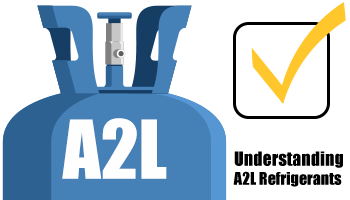Last year we wrote a post informing partners and customers of the impending refrigeration regulation changes coming to our industry for self-contained units. Now, the refrigeration industry is on the cusp of its most significant change in decades.
Beginning January 1, 2026, new federal regulations under the AIM Act (American Innovation and Manufacturing Act) will require commercial refrigeration systems to transition to A2L refrigerants—a class of mildly flammable, low-global-warming-potential (GWP) refrigerants. These changes will reshape how manufacturers, contractors, and end-users approach system design, installation, and compliance.
Why the Change?
The AIM Act, signed into law in 2020, established a framework to phase down high-GWP hydrofluorocarbons (HFCs) and encourage adoption of more climate-friendly alternatives. While air conditioning systems began their transition in 2025 (under SNAP Rule 25), commercial refrigeration faces new requirements in 2026 (SNAP Rule 26). The critical difference lies in commissioning dates:
- Air conditioning: Compliance based on date of manufacture.
- Refrigeration: Compliance based on date of commissioning (when the system first “makes cold”).
This means projects installed after January 1, 2026, must use A2L refrigerants—even if the equipment was purchased beforehand.
Key Refrigerant Threshold
The new rules establish strict GWP limits:
- Under 200 lbs of refrigerant: Maximum GWP of 300.
- Over 200 lbs of refrigerant: Maximum GWP of 150.
For most walk-in and small refrigeration systems, the industry-standard replacement will be R-454A, which closely matches the performance of legacy refrigerants like R-448 while staying under the 300 GWP limit. Larger systems, or installations in stricter states like California and New York, may require R-454C. A third option, R-455A, exists but comes with drawbacks such as suboptimal performance high ambient temperatures.
R454A
- Slightly higher condensing pressure to R448A
- Similar condensing temperature to R448A
- Similar discharge temperature to R448A
- Best A2L efficiency
- Smallest Glide
- GWP: 238
R454C
- Lower condensing pressure to R448A
- Higher condensing temperature to R448A
- Higher discharge temperature to R448A
- GWP: 148
R455A
- Similar condensing pressure to R448A
- Highest A2L condensing temperature
- Highest A2L discharge temperature
- Worst A2L efficiency
- Performance issues at high ambient conditions
- Largest glide
- GWP: 146
What Contractors Need to Know
- Date of Commissioning is Everything: Systems started after Jan 1, 2026, must use A2L refrigerants. No exceptions or sell-through allowances apply to remote refrigeration
- Repair and Replace Provisions: You can continue servicing and repairing existing systems with legacy refrigerants, even replacing major parts, without triggering A2L compliance. However, if you replace 75% or more of evaporators and 100% of compressor racks, condensers, and connected loads, the system is considered a new installation and must meet A2L requirements.
System Design Changes:
- Evaporators will now include leak sensors, additional wiring, and field-installed mitigation valves.
- Contractors effectively become the “manufacturer” of the system during installation, responsible for correct assembly and compliance.
- Quick-connect systems will no longer be available, as A2Ls require hard piping.


State-Level Complications
While the federal standard sets the baseline, individual states may adopt stricter measures. California, New York, and Washington are expected to enforce tighter GWP limits, making R-454C the required refrigerant in some markets. Contractors working across multiple states will need to stay informed of regional codes and enforcement trends.
What This Means for the Industry
The 2026 refrigeration transition represents a fundamental shift in both equipment design and installation practices. Contractors must prepare now by:
- Updating quotes and specifications for projects extending into 2026.
- Training teams on A2L system installation, piping practices, and safety protocols.
- Communicating clearly with customers to avoid compliance risks or costly rework.
This is not a temporary regulation—it is the federally mandated future of refrigeration. The earlier contractors and end-users adapt, the smoother the transition will be.
We will continue to update our partners and customers with news, infographics, and more as January 1, 2026, approaches.

